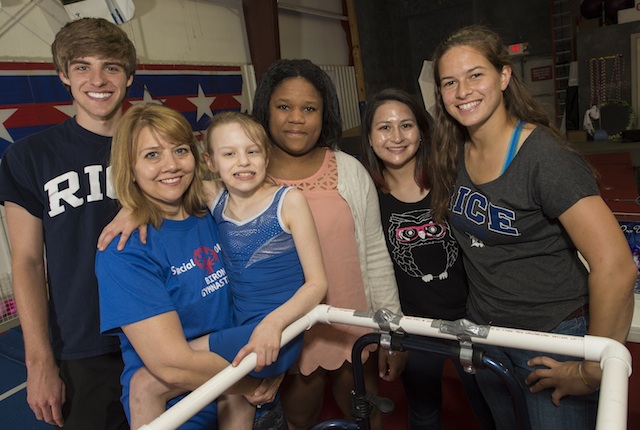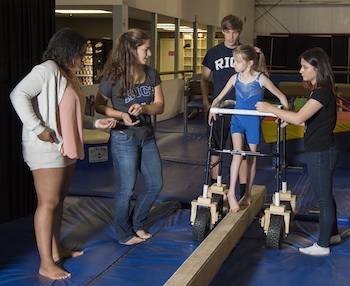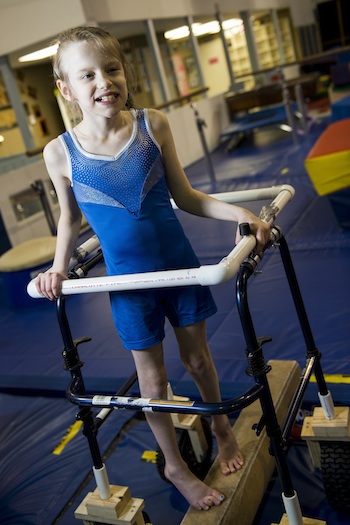
Rice freshman engineering students with their Special Olympian. From left: Austin James, Krista Bouchard and her daughter Macy, Mickyle Stanbury, Kylie Balotin and Kelsey Nanneman. Photo by Jeff Fitlow
Rice University students help Special Olympian gain independence for her favorite event
A 10-year-old Special Olympian is able to work her way along a balance beam without a helping human hand; an assistive device from a crew of Rice University freshmen gave her the independence she so desired.
Macy Bouchard has been working with Rice engineering students to test a device that allows her to compete in one of her favorite events without having to depend on an instructor to guide her. The Houston girl’s global development delays and blindness in one eye do not keep her from competing in gymnastics or dampen her desire to do so under her own power.
The students — bioengineering majors Kylie Balotin and Kelsey Nanneman, chemical and biological engineering major Mickyle Stanbury and mechanical engineering major Austin James — were drawn to Bouchard’s aid as part of their freshman engineering design class. The class is overseen by Ann Saterbak, a Rice professor in the practice of bioengineering education, who is advising the team with Rice bioengineering lecturer Renata Ramos.
Saterbak’s experience with own her child led her to believe Rice students could help others at Biron Gymnastics, a West Houston gym that specializes in training Special Olympians. In fact, Saterbak’s daughter Miriam, who has Down syndrome, came up with the idea to build a device for teammate Bouchard.
“Last summer, Miriam and I were brainstorming projects for her Girl Scout Silver Award, and she wanted to help her teammates in Special Olympics,” Saterbak said. “It was her idea to create the device because she wanted Macy to be independent.”
Bouchard and her parents, Krista and Butch Bouchard, were glad to have the help when the engineering team formed in January.
“Special Olympics is for kids with cognitive disabilities, and a lot of them don’t have the physical disabilities that Macy has,” her mom said. “On the beam, she has the most physical disabilities of anyone I’ve seen compete.”
The device the Rice students created is a modified walker with a rectangular PVC frame and special wheels. Bouchard holds the frame while balancing, and the wheels allow her to keep a steady, straight line as she walks the low beam. “She is far less independent on the balance beam than on the other three apparatuses,” James said. “For the beam, she had to be helped quite a bit. We were tasked with coming up with a device that allows Macy to be independent during her balance beam routine.”
The team settled upon the walker-based design after brainstorming “some really crazy ideas, like floating her using wires from above,” Stanbury said.
“A walker is something she’s actually used,” James added.
“There was a question of whether or not the walker was going to work on the mats or whether it was going to slip away from her,” Nanneman said of their first trial with Bouchard in late March. “When she said she loved it, immediately all the work we’d done was worth it.”
The freshman engineering course gives students two months to actually build; the students are put through extensive brainstorming and planning before they are set loose at Rice’s Oshman Engineering Design Kitchen, where they have the resources at hand to finish their prototypes.

Rice engineering students work with Special Olympian Macy Bouchard as she tests the latest prototype of a walker that gives her more independence for the balance beam event. The students, from left, are Mickyle Stanbury, Kelsey Nanneman, Kylie Balotin and Austin James. Photo by Jeff Fitlow
The team started with two standard walkers and added wheels and the frame, as well as side wheels that kept the prototypes from snagging on the low beam while Macy moved forward, backward and from side to side during her routine.
“Initially, the walker was supposed to be adjustable for all balance beams, but the more we thought about it, if someone needed this much help, they weren’t going to be working on the higher balance beams anyway,” Nanneman said.
In working with the girl, the students found they had to adjust the size of the frame for Bouchard’s reach and discovered their original wheels were prone to stalling where two gym mats met. They plan to install balloon-type wheels from Wheeleez, a team sponsor, before their final presentation near the end of the school year.
Ultimately, the device will remain at the gym, where Bouchard and other youngsters can use it to advance their skills. “I don’t think of it as therapy, but I think of it as giving the same benefit that therapy provides,” Krista Bouchard said. “There’s a kind of a movement to not have your kid in therapy all the time, because they miss out so much. One of the things I love, love, love about this is the interaction between the kids.”
As for the team members, who will show their work at the annual George R. Brown School of Engineering Design Showcase April 17, getting a good grade on the project is almost a secondary consideration. “I like seeing Macy’s big smile when she jumps off the beam and holds her hands up,” Balotin said. “She seems so happy.”



Leave a Reply